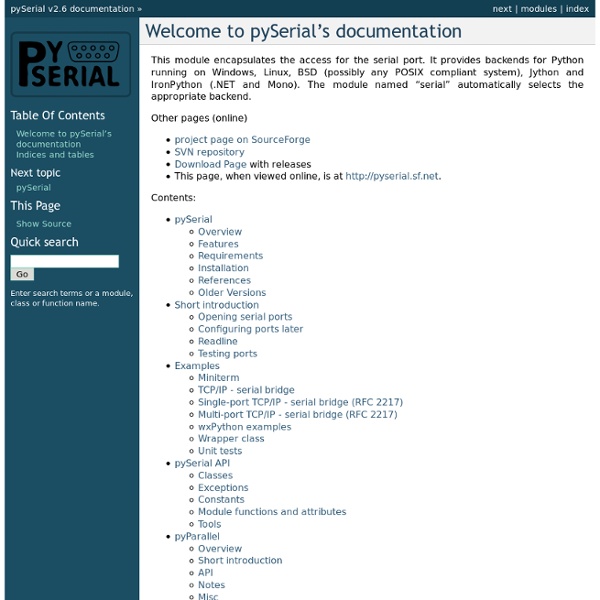



PIL The Python Imaging Library (PIL) adds image processing capabilities to your Python interpreter. This library supports many file formats, and provides powerful image processing and graphics capabilities. Status The current free version is PIL 1.1.7. Support Free Support: If you don't have a support contract, please send your question to the Python Image SIG mailing list. You can join the Image SIG via python.org's subscription page, or by sending a mail to image-sig-request@python.org. You can also ask on the Python mailing list, python-list@python.org, or the newsgroup comp.lang.python. Downloads The following downloads are currently available: Additional downloads may be found here. For a full list of changes in this release, see this page. If the Windows installer cannot find a Python interpreter, you may have to register your interpreter. For a full list of changes in this release, see this page.
blist Mark Hammond's Python Extensions This is Mark's collection of stuff... The Python for Windows extensions I'm the primary maintainer of the pywin32 package - please visit the project's SourceForge page SpamBayes I no longer get any spam in my Outlook inbox. Mozilla I do a lot of work on the Python XPCOM bindings and once wrote a cute Python sidebar for Mozilla. Books I have 2 now :) Python Programming on Win32 Andy Robinson and my book from OReilly titled Python Programming on Win32 has been released, and copies are now available. Programming in the .NET environment Co-written with Damien Watkins and Brad Abrams from Microsoft, this book isn't about Python (but I did make sure it got a number of mentions!). Australian Python Users Mailing List There is a mailing list for Australian Users of Python. Conferences You can find the beginning of my collection of conference papers, tutorials, sample code, etc. About these pages The base content is maintained using the Mozilla HTML Editor.
Django People pybluez PyBluez is an effort to create python wrappers around system Bluetooth resources to allow Python developers to easily and quickly create Bluetooth applications. PyBluez works on GNU/Linux and Windows XP (Microsoft and Widcomm Bluetooth stacks). It is freely available under the GNU General Public License. Documentation See the Documentation page. Mailing List / Contact Please use the mailing list at News Jan 19, 2014 Version 0.20 released. Oct 15, 2009 Version 0.17 released. Feb 5, 2009 Version 0.16 released. Jan 21, 2008 Version 0.15 released. Jan 3, 2008 We are slowly transitioning the website from MIT (org.csail.mit.edu/pybluez) to Google Code ( Nov 12, 2007 Version 0.14 released. Aug 30, 2007 Version 0.13 released. Aug 29, 2007 Version 0.12 released. Aug 25, 2007 Version 0.11 released. Aug 15, 2007 Version 0.10 released. added experimental Broadcom/Widcomm support. Widcomm stack notes: 1. Dec 27, 2006 Version 0.9.2 released.
Hidden features of Python The environment dictionary A simple but integral aspect of Fabric is what is known as the “environment”: a Python dictionary subclass, which is used as a combination settings registry and shared inter-task data namespace. The environment dict is currently implemented as a global singleton, fabric.state.env, and is included in fabric.api for convenience. Keys in env are sometimes referred to as “env variables”. Below is a list of all predefined (or defined by Fabric itself during execution) environment variables. While many of them may be manipulated directly, it’s often best to use context_managers, either generally via settings or via specific context managers such as cd. Note that many of these may be set via fab‘s command-line switches – see fab options and arguments for details. abort_exception Default: None Fabric normally handles aborting by printing an error message to stderr and calling sys.exit(1). abort_on_prompts Default: False all_hosts Default: [] always_use_pty Default: True colorize_errors Default False cwd key
PyPy :: PyPy Installing Django on an Ubuntu Linux Server Today I had the task of installing a development server running the Django Python framework for one of our web developers. I learned a few things and I figured a quick tutorial might help someone else out. None of this covers new ground, but perhaps another telling of the story will help someone out there. I started from scratch, with a basic install of Ubuntu 7.04 Server Edition. Install server software Install Apache, Mod_Python, MySQL and MySQLdb. sudo apt-get install apache2 libapache2-mod-python sudo apt-get install mysql-server python-mysqldb Install the Django source code At this point you have a couple of options. cd ~/ svn co django_src Python won’t recognize Django unless it is installed in the “site-packages” directory, so instead we just create a symbolic link to the source code in our home directory. Create Django’s directories Next we need to create some directories that Django will use. Create a Django project
Centrifuge набирает обороты Привет! Пару месяцев назад я опубликовал на Хабре статью, посвященную описанию open-source проекта Centrifuge. Напомню, что это сервер рассылки сообщений подключенным клиентам (в основном из веб-браузера) в реальном времени. С тех пор я продолжал работать над проектом в свободное время и сейчас готов поделиться накопившимися мыслями и изменениями. Изначально, Центрифуга была самобытным проектом. В конце июня я наткнулся на великолепную статью от Serge Koval — Python and real-time Web. С того времени я допиливал Центрифугу с прицелом на удобство использования и с оглядкой на pusher.com, pubnub.com и Faye. Вопрос, зачем мне нужно было писать код с нуля, если уже существуют более матерые и продвинутые аналоги, неизбежен. Это интересно. Теперь расскажу об изменениях, произошедших с момента написания предыдущей статьи о Центрифуге. Структура — проекты, пространства имен и их настройки — теперь по умолчанию будут храниться в SQLite — базе данных, входящей в стандартную библиотеку Python.
python - Greenlet Vs. Threads